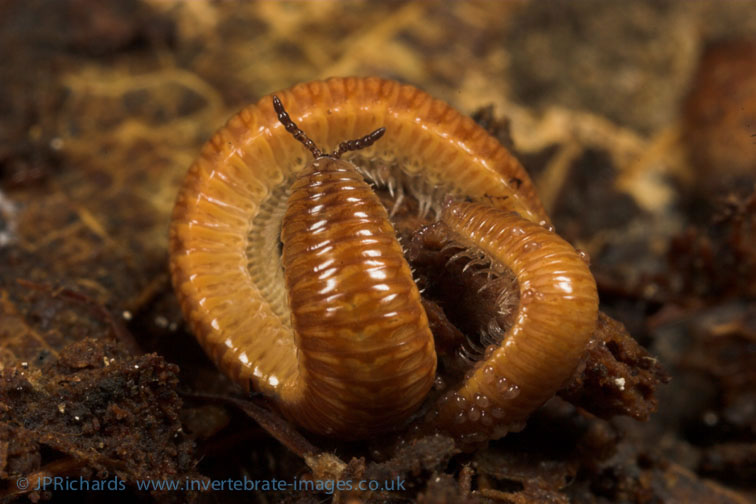Polyzonium germanicum Brandt, 1837
Common name
Status:
- GB IUCN status: Least Concern
- GB rarity status: Nationally Scarce
ID Difficulty
Identification
A distinctive rather slug-like millipede, some 5 to 18mm in length, with a yellowish to orange brown body and a very small triangular head (hence its common-name). When curled into a spiral it is said to resemble beech bud scales.
Distribution
Targeted surveys undertaken during the 2011 BMIG Annual Field Meeting, based in Kent, demonstrated that the species remains widespread in the county in suitable woodland habitat. There is a single record of this distinctive species from Surrey based on a section of moulted cuticle (Arthur, Cloudsley-Thompson & Sankey, 1951). Kime (1990) argued that it may have been more widespread in Britain 5000 years ago when the post-glacial climate was at its warmest.
There appear to be two main European populations, one in the eastern half of Europe and one in France, just extending into south east England. These populations are separated by a large area of northern central Europe from which there are only a handful of scattered records (Kime, 2001). Schubart (1934) found no differences between individuals from the two populations.
Habitat
Insufficient habitat data were available for reliable conclusions to be drawn from the analysis but 88% of the records with habitat data are from woodland. The first British specimens were also collected in mixed deciduous / coniferous woodland on chalk (Brade-Birks, 1920). The species has been taken by pitfall trapping in stands of chestnut / hazel coppice of different ages. It fell into traps in June, September and October but not July and August. Although present in all ages of coppice, the greatest number of animals occurred in the oldest (15 year old) coppice.
This species account is based on Lee (2006).
References
Arthur, D.R., Cloudsley-Thompson, J.L. & Sankey, J.H.P. 1951. Juniper Hall, Mickleham, Surrey. Entomologist’s Monthly Magazine, 87, 275-278.
Brade-Birks, S.G. 1920. Notes on Myriapoda XXI: Colobognatha, an order of diplopods new to Britain represented by Polyzonium germanicum (Brandt). Annals and Magazine of Natural History, (9) 5, 198-200.
Kime, R.D. 2001. The continental distribution of British and Irish millipedes, part 2. Bulletin of the British Myriapod and Isopod Group, 17, 7-42.
Kime, R.D. 1990. Spatio-temporal distribution of European millipedes. In: Proceedings of the 7th International Congress of Myriapodology, edited by A. Minelli, 367-380. Leiden: E.J.Brill.
Schubart, O. 1934. Diplopoda. Tierwelt Deutschlands. 28, 1-318.
Links
MilliBase - Global catalogue of Millipedes: https://millibase.org/aphia.php?p=taxdetails&id=938623





